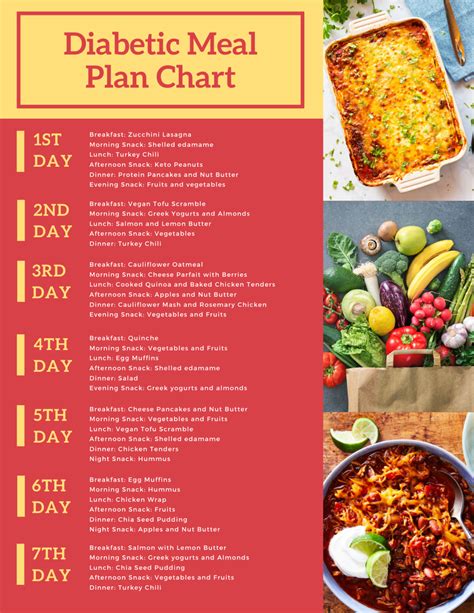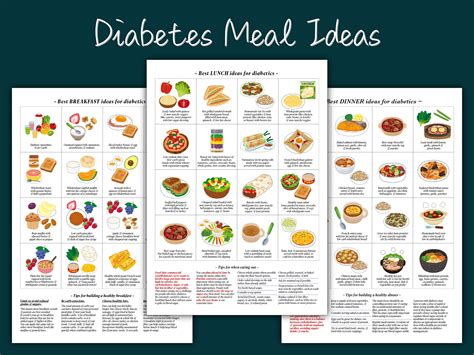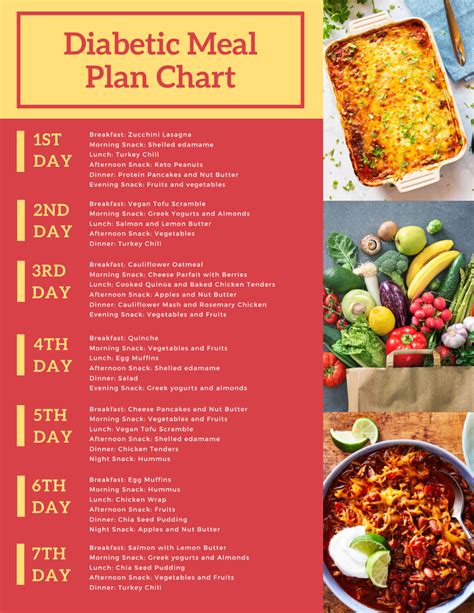Intro
Manage diabetes with 7 expert meal tips, covering healthy eating, portion control, and balanced diets, to help regulate blood sugar levels and improve overall well-being.
Living with diabetes requires a significant amount of planning and attention to detail, particularly when it comes to managing one's diet. A well-planned diabetic meal can help regulate blood sugar levels, maintain a healthy weight, and even prevent complications associated with the disease. With the numerous dietary restrictions and guidelines that come with diabetes, it can be overwhelming to determine what and how to eat. However, with the right approach and a bit of creativity, individuals with diabetes can enjoy a wide variety of delicious and nutritious meals that cater to their unique needs.
For individuals living with diabetes, meal planning is not just about monitoring carbohydrate intake, but also about considering the overall nutritional value of each meal. This includes paying attention to fiber content, protein levels, and healthy fats, as these can all play a significant role in regulating blood sugar levels and maintaining overall health. Furthermore, understanding how different foods affect blood sugar levels is crucial in making informed dietary choices. By adopting a balanced and flexible approach to meal planning, individuals with diabetes can take control of their condition and reduce the risk of complications.
A key aspect of managing diabetes through diet is developing a personalized meal plan that takes into account individual nutritional needs, lifestyle, and health goals. This plan should be tailored to provide the necessary nutrients, fiber, and energy while minimizing the risk of blood sugar spikes and crashes. With the guidance of a healthcare provider or registered dietitian, individuals with diabetes can create a meal plan that is both effective and enjoyable, allowing them to maintain a healthy and active lifestyle despite their condition.
Understanding Diabetic Meal Planning

To develop an effective diabetic meal plan, it is essential to understand the basics of nutrition and how different foods affect blood sugar levels. This includes learning about carbohydrate counting, glycemic index, and portion control. Carbohydrate counting involves tracking the amount of carbohydrates consumed at each meal, as these have the most significant impact on blood sugar levels. The glycemic index, on the other hand, measures how quickly foods raise blood sugar levels, with foods having a lower glycemic index being preferred for diabetic meal planning. Portion control is also crucial, as consuming large portions can lead to an excessive intake of carbohydrates, calories, and other nutrients.
Key Principles of Diabetic Meal Planning
Effective diabetic meal planning is based on several key principles, including: * Eating regular, balanced meals to maintain stable blood sugar levels * Choosing foods that are rich in nutrients, fiber, and healthy fats * Limiting the intake of added sugars, saturated fats, and refined carbohydrates * Staying hydrated by drinking plenty of water and other low-calorie beverages * Being mindful of portion sizes to avoid overeating and excessive carbohydrate intakeBenefits of a Well-Planned Diabetic Meal

A well-planned diabetic meal offers numerous benefits, including improved blood sugar control, weight management, and reduced risk of diabetes-related complications. By regulating carbohydrate intake and choosing nutrient-dense foods, individuals with diabetes can maintain stable blood sugar levels, reducing the risk of hyperglycemia and hypoglycemia. A balanced diet also supports weight management, which is essential for individuals with diabetes, as excess weight can exacerbate the condition. Furthermore, a healthy diet can help reduce the risk of complications such as heart disease, kidney disease, and nerve damage, which are common among individuals with diabetes.
Tips for Creating a Diabetic Meal Plan
Creating a diabetic meal plan can seem daunting, but with the right approach, it can be a straightforward and effective process. Here are some tips to consider: * Consult with a healthcare provider or registered dietitian to develop a personalized meal plan * Keep track of food intake and blood sugar levels to identify patterns and make adjustments * Focus on whole, unprocessed foods, including vegetables, fruits, whole grains, lean proteins, and healthy fats * Plan meals in advance to ensure that healthy options are always available * Be flexible and willing to make adjustments as needed to maintain a balanced and enjoyable diet7 Diabetic Meal Tips for Better Management

For individuals living with diabetes, managing the condition effectively requires a combination of lifestyle changes, including diet, exercise, and medication. When it comes to diet, there are several tips that can help individuals with diabetes make informed choices and maintain better control over their condition. Here are 7 diabetic meal tips for better management:
- Choose Whole, Unprocessed Foods: Whole, unprocessed foods, such as vegetables, fruits, whole grains, lean proteins, and healthy fats, are rich in nutrients, fiber, and antioxidants, making them ideal for diabetic meal planning.
- Monitor Carbohydrate Intake: Carbohydrates have the most significant impact on blood sugar levels, making it essential to monitor intake and choose complex carbohydrates, such as whole grains, fruits, and vegetables, which are rich in fiber and nutrients.
- Stay Hydrated: Drinking plenty of water and other low-calorie beverages can help regulate blood sugar levels, prevent dehydration, and support overall health.
- Be Mindful of Portion Sizes: Consuming large portions can lead to excessive carbohydrate and calorie intake, making it essential to be mindful of portion sizes and eat regular, balanced meals.
- Incorporate Healthy Fats: Healthy fats, such as avocado, nuts, and olive oil, can help regulate blood sugar levels, support heart health, and provide a feeling of fullness and satisfaction.
- Limit Added Sugars: Added sugars, such as those found in sugary drinks, desserts, and processed snacks, can cause blood sugar spikes and crashes, making it essential to limit intake and choose natural sources of sugar, such as fruits and vegetables.
- Plan Meals in Advance: Planning meals in advance can help ensure that healthy options are always available, reducing the risk of relying on convenience or fast foods, which are often high in added sugars, saturated fats, and refined carbohydrates.
Practical Examples of Diabetic Meal Planning
Incorporating these tips into daily life can seem challenging, but with a bit of creativity and planning, individuals with diabetes can enjoy a wide variety of delicious and nutritious meals. Here are some practical examples of diabetic meal planning: * Breakfast: Oatmeal with fruit and nuts, scrambled eggs with whole grain toast, or Greek yogurt with berries and honey * Lunch: Grilled chicken or fish with roasted vegetables and quinoa, whole grain pita with hummus and vegetables, or lentil soup with whole grain bread * Dinner: Grilled lean meats or fish with roasted sweet potatoes and green beans, stir-fry with brown rice and mixed vegetables, or vegetable curry with brown rice and whole grain naanCommon Mistakes in Diabetic Meal Planning

Despite the best intentions, individuals with diabetes can make mistakes in their meal planning, which can have negative consequences for their health. Here are some common mistakes to avoid:
- Not Monitoring Carbohydrate Intake: Failing to monitor carbohydrate intake can lead to excessive consumption, causing blood sugar spikes and crashes.
- Not Staying Hydrated: Inadequate hydration can lead to dehydration, causing blood sugar levels to rise and increasing the risk of complications.
- Not Being Mindful of Portion Sizes: Consuming large portions can lead to excessive carbohydrate and calorie intake, making it essential to be mindful of portion sizes and eat regular, balanced meals.
- Not Incorporating Healthy Fats: Failing to incorporate healthy fats can lead to inadequate nutrition, making it essential to include sources of healthy fats, such as avocado, nuts, and olive oil, in meals.
Overcoming Challenges in Diabetic Meal Planning
Diabetic meal planning can be challenging, particularly when it comes to navigating social situations, eating out, or managing cravings. However, with the right strategies and support, individuals with diabetes can overcome these challenges and maintain a healthy and balanced diet. Here are some tips for overcoming common challenges: * **Eating Out**: Choose restaurants that offer healthy options, and be mindful of portion sizes and carbohydrate intake. * **Managing Cravings**: Plan ahead and have healthy snacks available, and find healthy alternatives to satisfy cravings, such as fruit or dark chocolate. * **Navigating Social Situations**: Communicate with friends and family about dietary needs, and plan ahead to ensure that healthy options are available.Conclusion and Next Steps

Managing diabetes through diet requires a combination of knowledge, planning, and creativity. By understanding the principles of diabetic meal planning, incorporating healthy foods and portion control, and avoiding common mistakes, individuals with diabetes can maintain better control over their condition and reduce the risk of complications. With the right approach and support, individuals with diabetes can enjoy a wide variety of delicious and nutritious meals, improving their overall health and well-being.
We invite you to share your experiences and tips for diabetic meal planning in the comments below. If you have any questions or need further guidance, please do not hesitate to ask. By working together and sharing knowledge, we can support individuals with diabetes in achieving their health goals and living a happy and healthy life.
What is the best way to manage diabetes through diet?
+The best way to manage diabetes through diet is to develop a personalized meal plan that takes into account individual nutritional needs, lifestyle, and health goals. This plan should focus on whole, unprocessed foods, portion control, and monitoring carbohydrate intake.
How can I incorporate healthy fats into my diabetic meal plan?
+Healthy fats, such as avocado, nuts, and olive oil, can be incorporated into meals in a variety of ways, including adding them to salads, using them as a cooking oil, or snacking on nuts and seeds.
What are some common mistakes to avoid in diabetic meal planning?
+Common mistakes to avoid in diabetic meal planning include not monitoring carbohydrate intake, not staying hydrated, not being mindful of portion sizes, and not incorporating healthy fats into meals.
